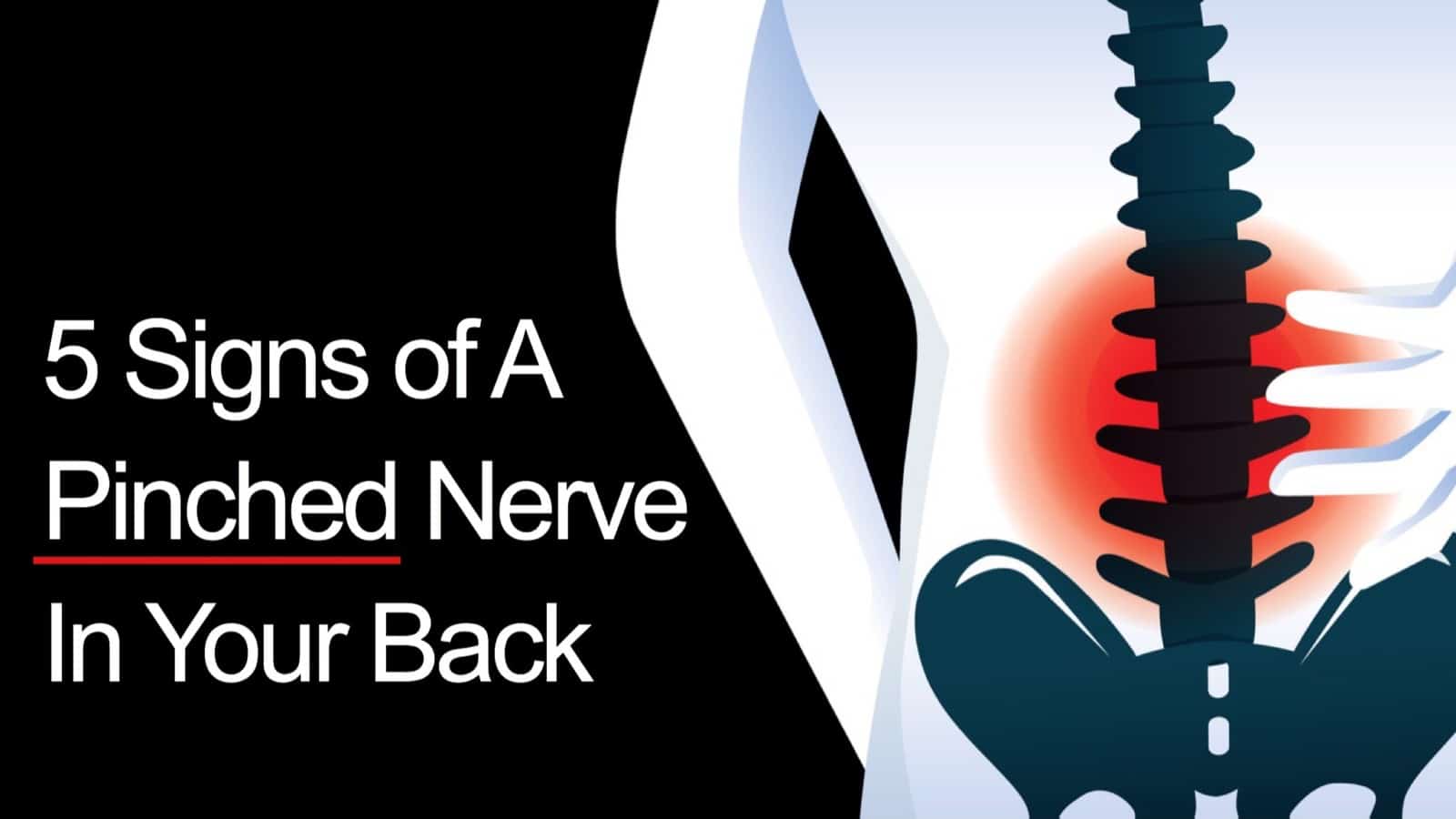A pinched nerve in the back is painful and uncomfortable. It happens when there’s too much pressure on the nerve surrounding your tissues because it disrupts your nerve function. When the nerve function is disrupted, you might experience feelings of pain, numbness, weakness, or tingling.
The nerve pressure is often exerted by the surrounding bones or tissues. A pinched nerve not only causes you pain but can also reduce the nerve’s ability to control your muscles. It can interfere with your daily activities and your overall life satisfaction, as well.
If the pinched nerve happens to be in your spine, you will experience pain throughout your body. The nerves in your spine extend to so many areas of your body that it might seem like the pain originated somewhere else. Since the nerves in your spine are contained within a tight space, they are often the source of pinched nerves.
Four Primary Causes Of a Pinched Nerve in the Back
Pinched nerves in the back aren’t only caused by spinal nerves, though, as they can happen to any nerve in the area. Knowing the signs will help you address the problem and find a remedy to alleviate the issue.
1 – Herniated Disks
Injury or weakness in your spine can cause the discs to protrude out of the spine, called a herniated disk. When this happens, it causes intense pain as the inner layer leaks out into the spinal canal. This situation puts excess pressure on the nerves in your back.
 2 – Spinal Stenosis
2 – Spinal Stenosis
When the bone channel occupied by your spinal nerves and spinal cord narrows, it is called spinal stenosis. This narrowing puts extra pressure on all of the nerves in the area.
3 – Bone Spurs
Bone spurs occur when a bone becomes enlarged. These spurs appear as sharp outgrowths of bone. Bone spurs often occur along the spine and lead to inflammation, causing cells to bring even more extra bone to the area.
4 – Sensory and Motor Nerves
You have sensory and motor nerve fibers, and when a nerve is pinched, both types of nerve fibers are affected. The intensity of the compressed nerve will determine the severity of the symptoms. Sensory and motor nerves can cause a pinched nerve in the back because they transmit signals to and from the spine.
5 Signs of a Pinched Nerve in the Back
Know the signs. Then, call your primary care provider for further guidance.
1. Dull Sensation or Numbness
If a sensory nerve in the back is pinched, its signal is negatively affected, impairing normal sensory perception. This pinched nerve presents itself as a dull or radiating numbing sensation.
2. Impaired Motor Coordination
Motor coordination relies on sending feedback to and from the brain, and it depends on the ability to stimulate the correct muscles. When your motor nerves are pinched, your brain can’t perceive feedback accurately. It can hinder your ability to do daily activities such as typing, writing, walking, or standing.
Unfortunately, the activities mentioned can also be the culprit of your pinched nerve. If your job requires that you do the same motor activity for an extended time, it could cause pressure on a specific nerve group.
3. Muscle Weakness or Atrophy
When motor nerves are pinched, it hinders the functionality of muscle contraction. If the functionality is impaired, you will experience muscle weakness. If you don’t get it taken care of quickly, muscle atrophy (shrinkage) can occur.
4. Pain or Burning
If you experience pain or a burning sensation, it likely means that the root of a sensory nerve is pinched. While it might be a pinched nerve in the back, you can experience the sensations in your legs, thighs, lower back, or buttocks.
5. Radiating Pain or Spasms
A pinched nerve in the back can cause spasms and radiating pain in your legs or lower back. Radiating pain is described as a shooting type of pain, and it is intense. Sciatica is one condition that can cause this type of pain in your hips, outer part of the leg, or lower back.
 9 Exercises to Relieve a Pinched Nerve in the Back
9 Exercises to Relieve a Pinched Nerve in the Back
Having a pinched nerve in the back can be painful, debilitating, and just downright annoying. Luckily, you can alleviate the problem at home by doing some exercises. These exercises can help you recover, restore movement, and prevent pinched nerves in the future.
Some exercises can make the pain worse, so avoid any that put more pressure on your back. If the pain, numbness, or tingling sensations worsen during your exercise, stop right away. These exercises will help most people dealing with a pinched nerve, but you’re always advised to use caution.
1. Isometric Strengthening
Strengthening your upper back and neck can help reduce pressure on your nerves in the back. For this exercise, you only need a chair so you can do it anywhere and anytime. You’ll use your hands to push against your head in different directions.
For the best results, do one set of isometric neck exercises two times each day. It will increase your strength in all directions of motion.
2. Lumbar Rotation
This exercise is beneficial for your lower back and doesn’t require any equipment. As you rotate your lower body, your thoracic spine reorients, allowing for less pressure on your nerves. Only rotate your body as far as is comfortable, and stop if you experience any pain.
3. Back Extensions
Back extensions are beneficial for relieving sciatica and other forms of back pain. As you do this exercise, focus on your breathing while keeping your head, neck, and spine aligned. Repeat the extension between eight and ten times each session.
4. Prone Head Lifts
This exercise will help restore the natural curve of your lower back. Restoring the natural curve relieves pressure in your back, reducing and preventing pinched nerves. Do prone head lifts twice each day, repeating it five times in both instances.
5. Supine Head Lifts
Similar to the prone head lift, this exercise helps support the natural curve of your spine. Repeat the head lift eight to ten times, two times each day.
6. Neck Rotation
You can do neck rotations while sitting or standing, and they improve your mobility and strength. With improved mobility and strength, you will experience less muscular tension and improved posture. These benefits relieve pressure on the nerves, reducing and preventing pinched nerves in the back.
7. Child’s Pose
This yoga exercise can offer immediate relief to a pinched nerve in the back. It soothes the pain and eases pressure in your lower back as it stretches your spine. Child’s Pose is easy for anyone to do, and it doesn’t require any equipment.
8. Leg Elevation
If you have a pinched nerve in the back, leg elevation can alleviate your discomfort. Make sure your knees and hips both have a 90-degree bend. You can use a stool or ottoman for this exercise, or you can place some pillows under your knees instead.
9. Standing Side Bends
A standing side bend can increase the flexibility of your spine and rib cage. It also helps you maintain proper posture, alleviating unnatural pressure on your nerves. This exercise can immediately relieve discomfort, making it ideal for lower back pain and pinched nerves.
Other Ways to Treat a Pinched Nerve in The Back
Exercise isn’t the only way to relieve a pinched nerve in the back. An orthopedic surgeon, Steward Eidelson, suggests alternating heat and ice on the problematic area.
Eidelson recommends applying heat for twenty minutes and then ice for twenty minutes, repeating this cycle until you find relief. Placing a towel around the heat and ice packs will protect your skin, so make sure to do that before beginning.
Sometimes muscle tension could be putting pressure on your nerves. In that instance, you can schedule a professional massage, which decreases muscle tension and offers quick relief.
Other ways to treat a pinched nerve in the back include:
- Lie down with a rolled-up towel under your neck
- Use a handheld massager on the affected area
- Take a light stroll
- Lie down and pulling your knees toward your chest
- Take a warm bath
Final Thoughts on Signs of a Pinched Nerve in Your Back
Having a pinched nerve in the back is uncomfortable, painful, and can interfere with your daily activities. Luckily, most people make a full recovery from this issue. Even better, you can alleviate the symptoms and prevent future pinched nerves by trying exercises and other treatment methods.
If your home remedies don’t help the pinched nerve, see a doctor as soon as you can. Ignoring the problem won’t make it go away, and it can result in further damage to your nerves and back. If the pain is too intense to do any of the suggested treatments, you should also see a doctor right away.
As you experience a pinched nerve in the back, you might become discouraged if you don’t know the source. Remember that pinched spinal nerves can cause pain throughout your body, though. Focus on exercises for relieving a pinched back nerve to help you find relief.



















